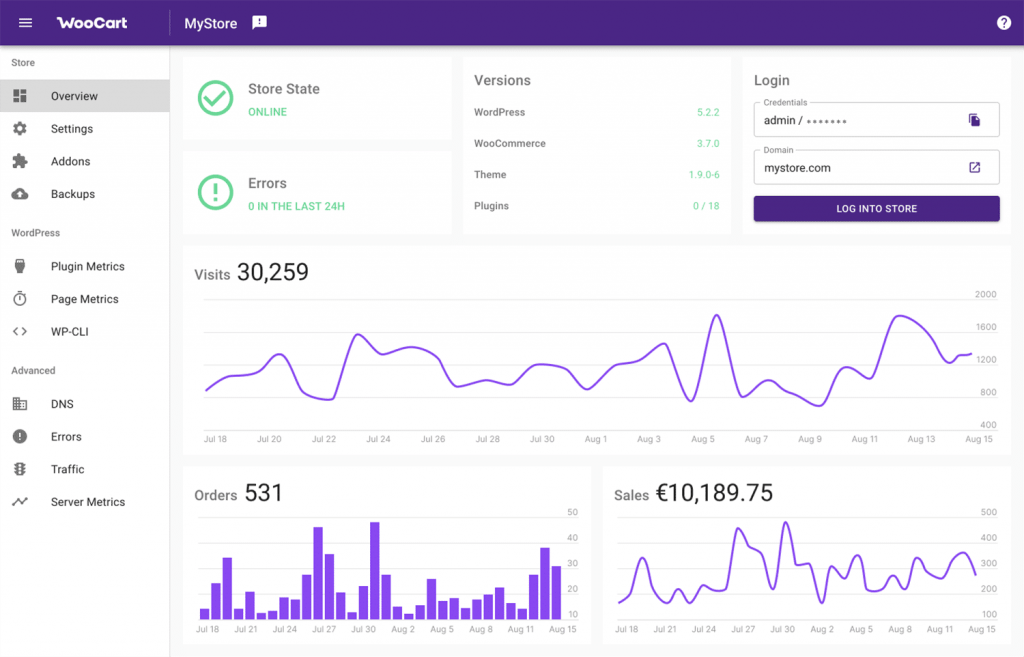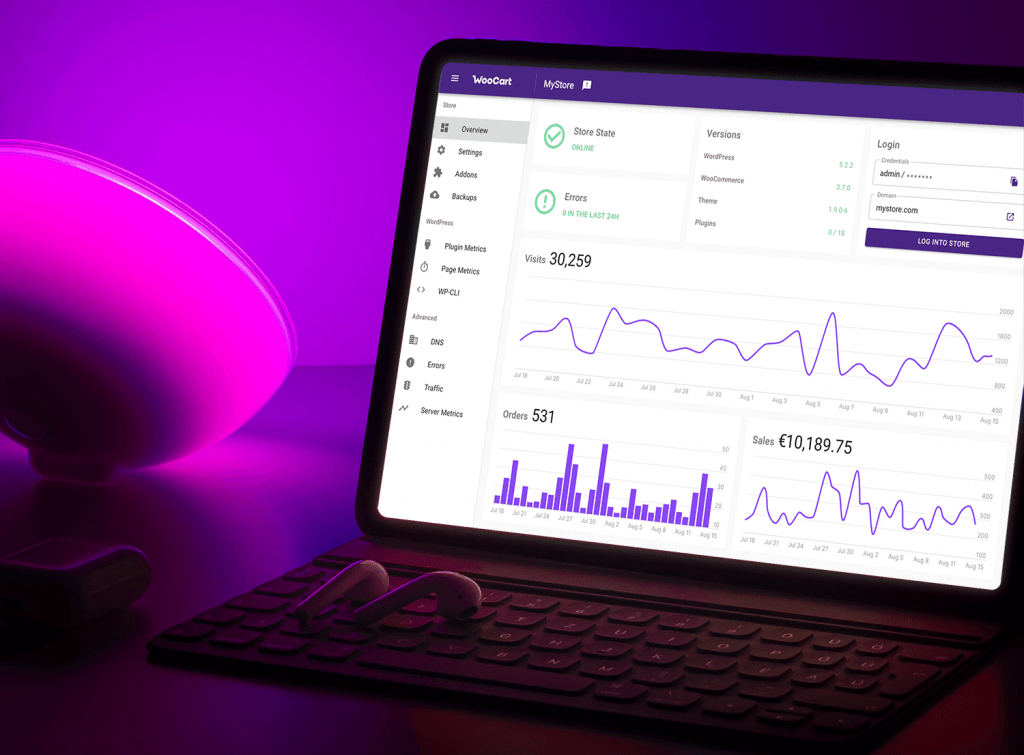
When a new version of the WooCommerce plugin is released, and the WordPress dashboard starts sending you notifications that it’s time to update, this question comes always to mind: “Should I update WooCommerce right now, wait a little longer, or stay on the same version unless something breaks?“
Well, updating WooCommerce is ALWAYS a big risk – potentially you can break your live website and miss out on traffic and sales. This can happen every time a significant update is released – many store owners don’t update their stores because they feel the hassle is not worth the effort.
But updating WooCommerce is definitely a good idea for the long-term. The main cause of WordPress hacking is because of out-of-date plugins and themes. And this is where staging environments come in.
A staging website is a clone of your existing live store. It’s completely separate and it doesn’t affect your live store in any way. Staging is also called “testing environment” or “sandbox”, while your live site is usually called “production environment”.
Staging gives you the benefit of 1-click-cloning in a few minutes, updating and testing WooCommerce without worrying about breaking your actual live website, and finally “pushing” the changes to the live website (a.k.a. overwriting the live environment), so the functioning is 100% guaranteed.
Hosting and WooCommerce-Friendly Staging
You might already be hosting with providers that offer staging such as WP Engine, SiteGround, Kinsta. The problem is that these hosts were not built with WooCommerce in mind, but WordPress.
What’s the difference you might ask?
Well, when you’re staging a regular, mainly static, brochure website, no major changes happen on the live website. But with a busy ecommerce website, there are new orders and new customer registrations coming in regularly. You can imagine that after a week from creating a staging environment, the two WooCommerce clones will be horribly out-of-sync.
The problem is that with the previously mentioned hosts, when you click “Push to Live”, the live store gets completely overwritten and all “new” data (new orders, new customers, new pages, etc.) goes lost. Which can be a disaster if you’re not aware of it.
So what’s the solution? Well, there’s always manual export and import of orders and customers. But that’s very cumbersome and will just make you want to update your store less often.
WooCommerce is now almost 9 years old but this one is still the biggest pain for the majority of store owners. How to update WooCommerce on staging, but then avoid losing new data once you “publish” the updated version?
Enter WooCart – Hosting Built for WooCommerce
WooCart is the first hosting built exclusively for WooCommmerce. Other hosts, like LiquidWeb and GoDaddy, offer managed WooCommerce, but it’s always part of their existing WordPress infrastructure. WooCart is built from the ground up for WooCommerce.
And it shows from the very first time you login. The dashboard is far from a hosting dashboard you’re used to and it looks closer to Shopify rather than Hostgator.
WooCart runs on Google Cloud Platform, similarly to many other WP hosts lately (Kinsta, WP Engine, SiteGround). But there’s one major difference: while other hosts offer shared hosting, WooCart provides dedicated hosting.
This means that your store has reserved resources on the server. The benefit is consistent performance and knowing that if something is going wrong it’s something you can fix and not because your neighbor is abusing their server resources.
Great performance doesn’t stop at servers, so WooCart also takes care of static assets delivery with a premium CDN (KeyCDN). One thing that I haven’t seen with other hosts is also automatic image smushing and optimization. Usually you need to use plugins, or even paid services for that, but you get this out of the box with WooCart.

WooCart’s Lossless Staging
The main innovation that WooCart brings to WordPress is simple staging publishing/pushing – Lossless Staging. This system knows how to sync the WooCommerce order and customer data from live to staging before overriding the live environment.
Here’s a video of how this looks in practice:
There are major benefits to this. Updates can now be done in literally minutes. The process would be:
- Create staging environment
- Bulk update everything on staging
- Review your staging store to see if everything looks good
- Test the checkout on staging
- If all is well, click “Publish to Live”
The store will get merged to live, with new orders synced so nothing gets lost. And if something breaks, no worries – take time to fix it, and once it’s done you can now merge it. WooCart also allows you to sync orders and customers at any time, which is great if you’re working on staging for a longer time.
This significantly simplifies the maintenance, testing, and updating of WooCommerce stores.
Other WooCart Tools
Staging is just one of the features of WooCart. If you’re not completely new to WordPress, you’ll benefit from Error Logs where you can review errors that are usually hidden by other hosts. Error logs usually show a broken plugin and can make troubleshooting a lot easier.
Another new feature is Plugin Metrics, where the system lists all plugins by memory usage. This is again very useful for finding plugins that hog your resources.
There’s so many other things that WooCart has but it would be just too much to list and explain. It’s best you visit their website and take a look at the details. However, here are my top 3 picks:
Website security
WooCart takes care of your store security as well and there is no need for security plugins. The brute force attack protection is provided by Google Cloud and their WAF (web application firewall) is automatically updated based on the daily threats.
To make you sleep better, they guarantee that if anything happens to your store, they will thoroughly clean up the mess. So you could say WooCart gives you a “no hacked website guarantee”.
That’s, of course, as long as you follow their guidelines and notifications and don’t keep your store outdated and vulnerable. But since they solved updating plugins and themes with Lossless Staging, it’s a very reasonable guarantee.
Store Wizard and Localization
If you’re building a few stores every month, you probably have a template you reuse for each client. But WooCart created something even better, a Store Wizard. It localizes the store settings based on the store country. These settings include country standards, like currency, time format, date format, etc., installation of language packs where necessary and a lot of other small things. The localization files are entirely open-source and are available on their GitHub repository.
It’s a simple thing but one that will remove some menial work that happens regularly with every new client.
Store Wizard is a great feature, and it feels like there’s a lot of potential in it. And the project lead, Dejan Murko, agrees and promises there are more features coming with a big emphasis on turnkey stores (think industry-specific one-click stores).
Limitations
With a fully managed solution like WooCart, there are always some compromises. One is a black list of plugins that WooCart doesn’t let you install. It spans from performance and security plugins to plugins that reportedly had issues or unfixed vulnerabilities. To their defense, all of it sounds very reasonable. You just might need to adapt a bit. And remember, security is already guaranteed.
Advanced users might also miss phpMyAdmin for database management. Database access is available with WP-CLI, but that’s not that easy to manage. I was told that they might add it in the future but that there has not been enough demand yet to justify the investment.
I think these compromises make sense for most users, but you’ll be the final judge for your use case.

Summary
WooCart is not cheap. It positions itself at the top of the managed WordPress host prices. That said, it does offer a lot for the price. From dedicated server resources, premium CDN, to Lossless Staging and a bunch of other amazing tools.
In the end, it all depends on where you are. If you’re new to WooCommerce, you should probably start somewhere cheaper. But if your store is making money, it becomes a no-brainer. Just the time and frustration saved every month is worth double the price difference. Plus, they offer free trial and free website transfer within the trial period so it’s completely risk-free to try out.

